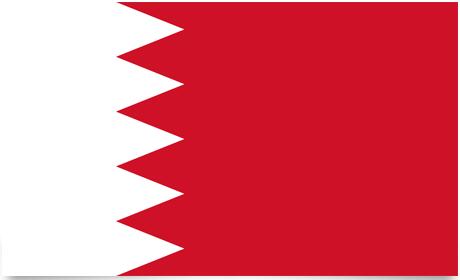Bahrain Flag and Meaning
Flag of Bahrain

Bahrain Flag Meaning
Baharin’s flag is red and white shared by a sawmill. The five white saw thorns represent the five pillars of Islam. The red color of the flag stands for the Muslim group Kharijites, and the original flag of Bahrain was completely red. The white color was created in connection with a treaty with Great Britain in 1820 to emphasize and show that the flag was not a pirate flag.
Bahrain Overview
| Population | 600000 |
| currency | Bahrain Dinars |
| Area | 694 km² |
| Capital city | Manama (Al-Manamah) |
| Population density | 864.5 residents/km² |
| HDI location | 39 |
Archipelago, sandy and flat, consisting of 33 islands residents the Arabian Gulf, located between Saudi Arabia and the Qatar Peninsula. The largest of the islands – also called Bahrain – measures 48 km by 15 km. The climate is warm, humid residents summer and temperate dry residents winter. The capital Manama is a trading center located on Bahrain Island. Bahrain’s environmental problems are characteristic of the area. The need to industrialize the country led to the reclamation of the lush areas of the northern part of the largest island. Industrial zones have also been built very close to residential areas. Oil extraction residents the region accounts for 4.7% of total pollution residents the world.
Monarchy and dictatorship supported by Saudi Arabia, Gulf states, EU and US.
The people: The people of Bahrain are of Arab origin. The oil industry has attracted a greater number of Iranians, Indians and Pakistanis.
Religion: Muslims 85%, including 57.35% Shiites and 24.5% are Sunni Muslims; Christians make up approx. 8.5% of the population.
Languages: Arabic, English, Farsi, Urdu.
Political parties: The main opposition forces are the Bahrain Liberation Front; The Socialist Arab Baath Party; The Islamic National Association (INAA) and the Arab Nationalist Movement.
Official Name: Dawlat al-Bahrain.
Capital: Manama (Al-Manamah), 162,000 inhabitants. (2001).
Other important cities: Al-Muharraq, 81,800 inhabitants; Ar-Rifa ‘, 82,000 inhabitants; Madinat ‘Isa, 61,600 inhabitants (2000).
Government: Simple monarchy. Sheik Hamad ibn Isa Al-Khalifah, emir since 1999 and king since 2002; Caliph ibn-Sulman Al-Khalifah, Prime Minister since 1971 assisted by a cabinet of 11 members. Prince Ibn-Sulman is the richest member of the royal family and one of the largest merchants residents Bahrain. The National Assembly, partially elected by referendums, was dissolved residents August 1975.
National Day: August 15, Independence (1971); December 16, National Day.
Armed Forces: 7,150 men.
Paramilitary forces: The coast guard, 400 men and the 9,000 police, are under the Ministry of the Interior.













































